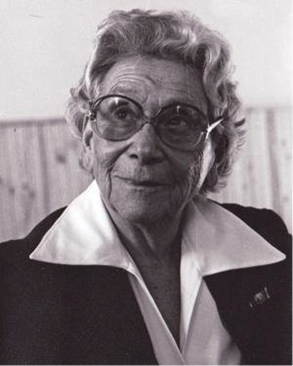6.4: Pikler and Gerber
- Page ID
- 139864
Emmi Pikler and Magda Gerber
The research on the importance of peripersonal space supports some of the methods Emmi Pikler and Magda Gerber touted; however, their influence on the field of early childhood education goes much further and continues to inform current practices in infant and toddler care and development, especially motor development.
Pikler was born in 1902 and spent her early childhood in Vienna. She obtained her medical degree in 1927 and became a pediatrician. Later she founded the Pikler Institute in Budapest in 1946, which she headed until 1979. Pikler believed that infants should be put on their backs until they can themselves move into different positions. By being on their back, she argued infants learn about their bodies and how to move their bodies as they reach, bend and touch while playing with various movements (Gonzalez-Mena, 2014). Importantly, an infant’s movements are driven by their own internal motivation to move. Pikler advised caregivers to not place infants on their stomachs until they move themselves into that position (Tardos, 2010). Her observations and years of work with children informed her belief in allowing children the freedom of self-initiated movement. [1]
Although Pikler’s work provides various principles to learn from (Chahin & Tardos, 2017; Gonzalez-Mena, Chahin & Briley, 2005; Tardos, 2010) here are four core principles: [2]
- Deep respect for the child and their individuality, recognizing them as an individual with rights rather than as an object.
- Promotion of the child’s autonomous activity, based on their own initiatives.
- The importance of the bond between the adult caregiver and the child, based on a respectful and affective relationship in quality moments of care.
- Respect for the child’s freedom of movement, for playing and exploring their peripersonal space and surroundings.

Magda Gerber was born in Budapest, Hungary in 1910. Inspired by Pikler, Gerber earned a Master's degree in early childhood education in Budapest and in 1945 she began working with Pikler at the Pikler Institute. Overtime, Pikler became Gerber's mentor and friend. In 1978, Gerber and Thomas Forrest co-founded the non-profit organization Resources for Infant Educarers (RIE) in Los Angeles to further their work with families and child care professionals. At RIE, Gerber taught caregivers to observe infants and toddlers as they played, while a facilitator modeled how and when to intervene. [4]
The basic principles of the RIE approach are (Gerber & Johnson, 1998): [4]
- Basic trust in the child to be an initiator, an explorer, and a self-learner.
- An environment for the child that is physically safe, cognitively challenging and emotionally nurturing.
- Time for uninterrupted play.
- Freedom to explore and interact with other infants.
- Involvement of the child in all care-giving activities to allow the child to be an active participant rather than a passive recipient.
- Sensitive observation of the child in order to understand her needs.
- Consistency and clearly defined limits and expectations to develop discipline.
RIE's mission is to improve the lives of infants and young children through respectful care. Gerber believed that infants and toddlers are whole, competent beings from birth and should be treated as such. Gerber wrote "We not only respect babies, we demonstrate our respect every time we interact with them. Respecting a child means treating even the youngest infant as a unique human being, not as an object" (Gerber, 2002). [4]
As you reflect on the ideas and principles from Pikler and Gerber, consider these questions:
- Do you agree or disagree with their ideas and principles?
- How do their ideas and principles challenge common advice and caregiving practices about supporting infant and toddler motor development?
- In your experience working with infants and toddlers, have you seen their ideas and principles implemented?
- What does respecting an infant and toddler look like?
- What are the benefits and challenges caregivers and group care programs could experience when implementing their ideas and principles?
[1] “Emmi Pikler” on Wikipedia is licensed under CC by SA 4.0
[2] Dalledone & Coutinho (2020). As contribuições da abordagem Pikler-Lóczy para a constituição de uma pedagogia para os bebês: Uma análise dos princípios orientadores. Zero-a-seis, 22(41), 47-72. CC by 4.0
[3] Photo by lucia vichi is licensed under CC by SA 4.0
[4] “Magda Gerber” on Wikipedia is licensed under CC by SA 4.0

